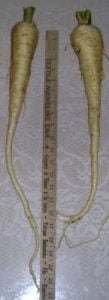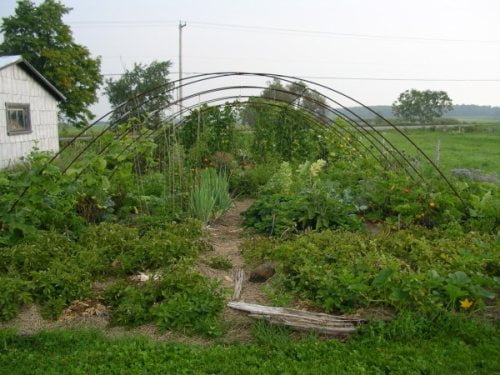Note: this profile was written in 2008, though the information is still largely up to date, and we have added photojournals from subsequent years.
Stephane Groleau has a large veganic garden in St-Casimir, Quebec. The garden was first established in 2005, and a short photojournal (with French descriptions) can be viewed online from 2005, 2006, 2007, 2008, 2009, 2010, 2011, 2012, 2013, 2014, 2015, 2016, 2017, 2018, 2019, and 2020.
The garden produces a wide variety of vegetables, and also herbs and berries. It is currently non-commercial, although some of the produce is exchanged with friends and family during the growing season. Much of the harvest is placed in cold storage to be eaten during the winter months, or preserved by canning, freezing, and dehydrating.

The garden is largely self-fertilizing. There are many types of plants growing near each other, and all crop residues are left on site to create fertility for future plants. For organic amendments, Stephane mainly adds hay as a mulch. This minimizes the need for weeding and watering, feeds the microorganisms in the soil, protects the soil from erosion, and reduces the risk of nutrients leaching. The mulch generally retains enough water that Stephane can leave his garden for more than a week without tending to it. Some kitchen compost is used for fertility when transplanting demanding seedlings.
Since there is a diversity of plant families and root shapes in the same bed, there is no crop rotation as such, but rather the gardener simply avoids replanting the same kind of plant in the same spot the following year. In self-fertilizing gardens, we call this “crop succession”.
Caring for the land and encouraging biodiversity are central to the garden. A small pond, trees, and flowers have been integrated for this reason.

The gardener is a vegan with a college background in organic agriculture, and he also did a 9-month tour of veganic farms in Europe. He decided to start gardening veganically to show that it’s possible to grow food without animal inputs. He gets his inspiration from different approaches, but especially the approach of self-fertilizing gardens.
If you would like to visit or to communicate with the gardener, contact us for information.
Stephane is a co-founder of the Veganic Agriculture Network, active member of the Vegan Organic Network, and also runs a website Vegeculture that provides information about veganic agriculture in the French language.








